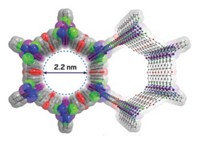Advertisement
Grab your lab coat. Let's get started
Welcome!
Welcome!
Create an account below to get 6 C&EN articles per month, receive newsletters and more - all free.
It seems this is your first time logging in online. Please enter the following information to continue.
As an ACS member you automatically get access to this site. All we need is few more details to create your reading experience.
Not you? Sign in with a different account.
Not you? Sign in with a different account.
ERROR 1
ERROR 1
ERROR 2
ERROR 2
ERROR 2
ERROR 2
ERROR 2
Password and Confirm password must match.
If you have an ACS member number, please enter it here so we can link this account to your membership. (optional)
ERROR 2
ACS values your privacy. By submitting your information, you are gaining access to C&EN and subscribing to our weekly newsletter. We use the information you provide to make your reading experience better, and we will never sell your data to third party members.
Materials
Nanostructure boosts CO2 uptake
A highly porous magnesium boron hydride crystal sops up CO2 under mild conditions
by Katherine Bourzac
September 28, 2019
| A version of this story appeared in
Volume 97, Issue 38

Jeffrey Urban and his colleagues at the Lawrence Berkeley National Laboratory noticed something surprising during their study of a potential hydrogen-storing material. When they grew magnesium borohydride on reduced graphene oxide, it formed an unusually open and porous crystalline nanostructure. “Working with the playbook of the periodic table, most inorganic crystals are dense,” Urban says. But the gamma form of crystalline magnesium borohydride (shown) is an exception. Contemplating the material’s large surface area and its plethora of exposed, reactive borohydrides, postdoc Sohee Jeong had “a chemical intuition that it would soak up CO2,” Urban says. She was right. Detailed studies revealed that the material initially works slowly, as the borohydrides first reduce the gas to create formate groups. There is then a stepwise spike in carbon dioxide uptake, forming methoxide groups (Adv. Mater. 2019, DOI: 10.1002/adma.201904252). A version of the material pretreated to create the formate groups works as well as existing CO2-scrubbing materials, but under much milder conditions. “It’s a massive thermodynamic sink for CO2,” even at ambient temperature and pressure, Urban says. He expects the material will find use in scuba-diving systems, space stations, and other enclosed spaces. But since it takes high temperatures to regenerate the material and release CO2, it would be challenging to adapt to industrial carbon capture and storage systems.
CORRECTION
This article was updated Sept. 30, 2019, to correct the name of the researcher interviewed. It is Jeffrey Urban, not Jeffrey Long.





Join the conversation
Contact the reporter
Submit a Letter to the Editor for publication
Engage with us on Twitter